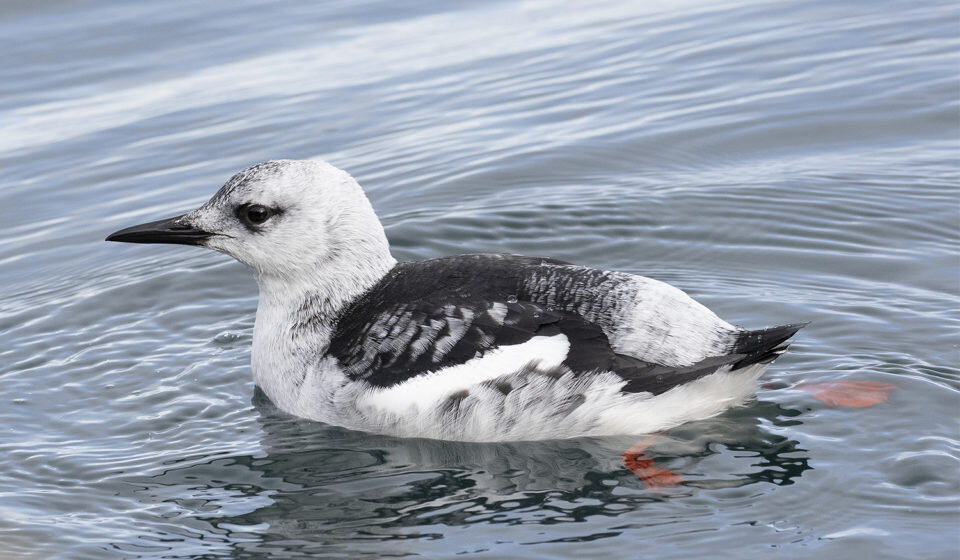The Olympus Mirrorless Revolution - Part 2
One of my first trips out with my new Olympus set up, I enthusiastically headed to the harbour in probably the worst weather conditions for some time, constant half light & drizzle. Well what better way than to dive straight into difficult photographic conditions with totally new gear - it's going to be a steep learning curve but I'll start at the deep end. The seabirds I had been hoping to see weren't around, but opportunistically, a trawler had just come into shelter from the stormy weather and a number of seals gathered around the boat, heads straining above the choppy waters....my first photo victims.
Atlantic Grey Seal - Olympus 300mm prime f.4 pro lens. ISO 800, f5.6, 160/sec
First impressions were good, the auto-focus was fast & locked on to the seals quickly considering the movement of the water. I found ISO 800 my preferable limit before noise began to show too much and quality possibly began to be compromised. At this early session I was hesitant to hand-hold with low speeds, settling for 1/160 sec to try and freeze the seal in the relatively fluid, wild weather - most shots of the seals at 100% did seem surprisingly sharp given the low shutter speed and low depth of field.
A regular Lerwick scene but gulls are a great way of practising various exposures and modes with new gear. If there is a sniff of bread, gulls often flock around the car and 'hang out' giving plenty of stationary subjects to practise on. ISO 800 f/5.6 1/100sec Olympus E-M1X with 300mm hand held.
Atlantic Grey Seal in choppy waters and low light - good results though a little grainy at 100%. ISO 1600, 1/250sec, f5.6.
ISO 1600, 1/320sec, f5.0. I love birds against ships, for the urban wildlife/natural abstract quality. Here the deep red ship worked well though at ISO 1600 there was notable grain with such a dark, one coloured, saturated background.
Taking an exposure reading from the bow of the ship. I was so impressed with the quality of the initial bright, pin sharp shots. Here an easy subject which didn't move. ISO 1600, 1/400sec, f/5.6.
Most of my images are taken using continuous autofocus (C-AF) mode as a lot of the time I am working with birds, which are notoriously difficult to photograph as so often on the move, so a good, fast continuous AF is a real advantage to the bird photographer. Also, with so many of my images now take from a boat in the summer months and from the shore (or car!) of birds on the sea in the winter months, even slow birds are continuously moving on water, so also cry out for a good C-AF mode. Although early days, I have so far found the Olympus E-M1X coupled with 300mm f4 pro lens to be incredibly fast both with the initial lock on the subject and the subsequent tracking and focusing, getting a much higher hit rate than I had previously been used to with my DSLR.
A few days later whilst experimenting in the harbour, photographing swimming tysties (black guillemots) and dunters (Common Eider) flocks feeding close to shore, I started using a new mode which immediately grabbed by attention = the continuous autofocus tracking or CAF+TR. I was perhaps reluctant at first, having been dabbling and gaining confidence with fine results in the basic C-AF mode alongside enjoying the little AF joysticks to quickly alter my focal point and position of the bird in each frame. However I was really pleasantly surprised at the fast focus and continued tracking obtained in this new mode and the high percentage of good, sharp imagery.
Rebecca Nason.
Common Eider, a flock of males moving briskly through harbour waters 1/500 sec, f/7.1, ISO 800 C-AF mode hand-held.
A smart male Common Eider taken using the CAF+TR mode.. ISO 500, f/6.3 1/400sec. This mode was quick to hit onto the subject and continually track it in focus (for 80% + of the 10 shots taken) as it moved across the water at some speed.
This black guillemot was busy feeding close to shore. 1/320 sec, f/7.1, ISO1600 C-AF mode, hand-held.
Good detail obtained with fine droplet of water on the black guillemots back and tail even at ISO 1600. Image enlarged to 200%.
Poor weather conditions, a little wing blur but perfectly sharp head and body. Olympus E-M1X, 300mm ISO 800, 1/320 sec f/7.1










